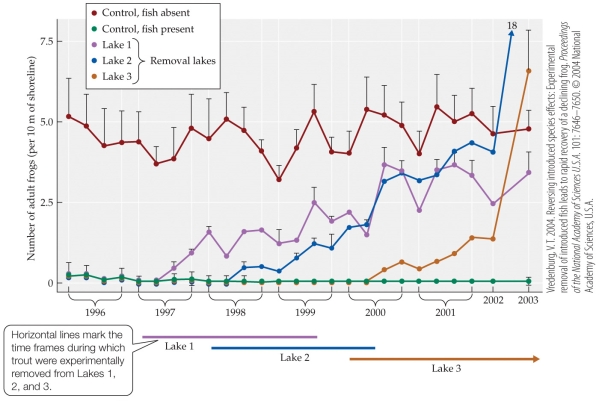Multiple Choice
Refer to the figure. Vredenburg studied the impact of the introduction of rainbow and brook trout on a species of amphibian, the mountain yellow-legged frog (Rana muscosa) . After showing greatly decreased frog populations in lakes with trout, he set up an experiment using three categories of lakes: lakes from which he removed trout, lakes that had never had trout, and lakes that still contained trout. He compared the number of adult frogs per 10 m of shoreline in all groups, as shown in the figure. What is the most likely reason that Vredenburg chose to use a large-scale experimental design such as this, rather than a single lake or laboratory experiments?
Vredenburg studied the impact of the introduction of rainbow and brook trout on a species of amphibian, the mountain yellow-legged frog (Rana muscosa) . After showing greatly decreased frog populations in lakes with trout, he set up an experiment using three categories of lakes: lakes from which he removed trout, lakes that had never had trout, and lakes that still contained trout. He compared the number of adult frogs per 10 m of shoreline in all groups, as shown in the figure. What is the most likely reason that Vredenburg chose to use a large-scale experimental design such as this, rather than a single lake or laboratory experiments?
A) The larger design allowed Vredenburg the ability to do replications.
B) A smaller study would not adequately answer the experimental question.
C) In a larger study, it is easier to manipulate the various experimental treatments.
D) In a real-world situation such as this, all variables can be more easily controlled.
Correct Answer:

Verified
Correct Answer:
Verified
Q1: What is one reason that amphibians are
Q2: What evidence led Ruth and Sessions to
Q3: Which statement about the concept of natural
Q4: A scientist monitors both the pollution entering
Q6: Refer to the figure.<br><img src="https://d2lvgg3v3hfg70.cloudfront.net/TBO1115/.jpg" alt="Refer to
Q7: Refer to the figure.<br><img src="https://d2lvgg3v3hfg70.cloudfront.net/TBO1115/.jpg" alt="Refer to
Q8: Refer to the figure.<br><img src="https://d2lvgg3v3hfg70.cloudfront.net/TBO1115/.jpg" alt="Refer to
Q9: The most appropriate spatial scale for a
Q10: Net primary production (NPP) is the amount
Q11: Refer to the figure.<br><img src="https://d2lvgg3v3hfg70.cloudfront.net/TBO1115/.jpg" alt="Refer to